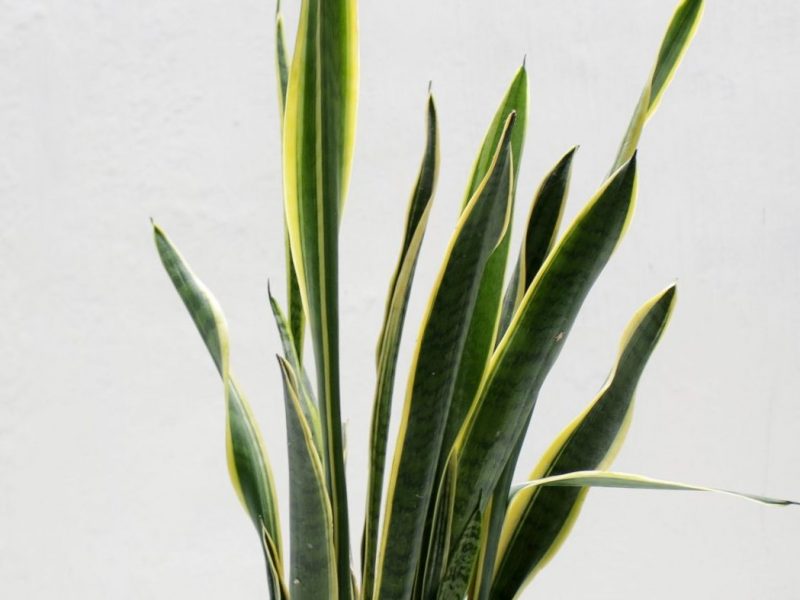
Basic Snake Plant Care
Snake Plants are very low maintenance plants that adapt and thrive in most conditions, perfect for first-time plant-parents. Below you will find all the information you need to care for a Snake Plant, including basic care tips and diagnosing common issues.
| Light |
Bright Indirect LightI love the sunshine but too much direct light will damage my leaves. |
| Water |
Water InfrequentlyI can be quite sensitive to root rot so be careful not to overwater me. |
| Humidity |
High HumidityI thrive in humid environments so please mist my leaves every so often. |
| Soil |
Potting SoilI need soil specifically for indoor plants as it retains the right amount of water. |
Snake Plants prefer bright, indirect light
They will also tolerate more direct sunlight or shadier corners. Imperfect light conditions will mean your Snake Plant will grow slower than in brighter environments but it will not kill it.
Snake Plants need very infrequent watering
Although they may not look like it, snake plants are actually a succulent so it can be very easy to accidentally over-water them. They like to dry out in between waterings and during winter, they only need to be watered around once a month.
Snake Plants prefer warmer environments
Being native to warmer countries, Snake Plants thrive in warmer conditions. In colder months, make sure your snake plant is not near drafty windows or doors.
Natural humidity is fine for your Snake Plant
One thing you don’t need to worry about when caring for a Snake Plant is humidity. They grow well in the natural level of your home, and don’t need any additional misting.
Use a well draining soil
Snake Plants need dry conditions so make sure that you use well-draining soil.Snake plants are one of the best plants at air purification. They filter out toxins at night which makes them great for the bedroom too.
Snake Plants can be propagated by division or leaf cutting
Try to divide and repot in the spring so that it can adjust to its new environment during the warmer months. To propagate a Snake Plant by division, cut a section of both leaves and roots and transfer into a separate pot. To propagate your Snake Plant by leaf cutting, slice 5-7cm of a leaf and place it either in water or a well-draining potting mix.
Snake plants are mildly toxic.
Snake Plants can be harmful to cats and dogs if ingested and cause diarrhoea or vomiting. They also have quite tough and sharp leaves so make sure to keep out of reach of pets and young children.
Snake Plants survive well when pot-bound
Don’t feel you need to re-pot your Snake Plant as soon as possible as they quite enjoy having their roots packed in tight. But if you want to rehome your plant just make sure you don’t bury it any deeper than it had been in its previous pot.

Snake Plant FAQs
Quick and simple answers to the most common questions we see about the Snake Plant.
Are Snake Plants good indoor plants?
Snake Plants make some of the best potted houseplants as they are super easy to care for and aren’t that fussy about their environment. They will adapt well to most rooms and you won’t find too many issues.
Can Snake Plants tolerate full sun?
Most of the time, Snake Plants will thrive in full sun, making them one of the only plants to withstand direct light. However, in the height of summer, if there’s no ventilation, the direct sun can cause hotspots to form near windows which might dry out the leaves on your Snake Plant.
How often should I water my Snake Plant?
Snake Plants don’t like moist soil and thrive when watered infrequently. This is about twice a month during summer and once a month during winter. However, there are many factors that impact how often you should be watering your Snake Plant so take that as a guide and adjust as necessary.
How tall do Snake Plants get?
If grown in the right environment, Snake Plants can grow to about 2 meters in height. They are very slow-growing though so it will take many years for it to mature to this height.
Are Snake Plants toxic?
Snake Plants can be harmful to pets if ingested and cause diarrhoea or vomiting. They also have quite sharp leaves so make sure to keep out of reach of pets and young children.

Common Problems with your Snake Plant
Here are some common issues that you might run into. It's important to diagnose any issues early to give your plant the best chance of bouncing back.
Why are there brown spots on my Snake Plant's leaves?
Brown spots on a Snake Plant can be caused by too much or too little water or can also be due to fungus or bacteria on the leaves. It can sometimes be difficult to diagnose the problem right away but start by inspecting the moisture in the soil to rule out any watering issues.
Why are my Snake Plant's leaves losing their bright green colour?
If your Snake Plant is losing leaves, then it may be a sign of overwatering. This is the most common cause of issues in Snake Plants as even a slight overwatering can cause root rot.
Why is my Snake Plant quite unstable?
Make sure you are always watering your Snake Plant from the bottom as this will encourage the roots to grow down, keeping the plant stable and upright.














